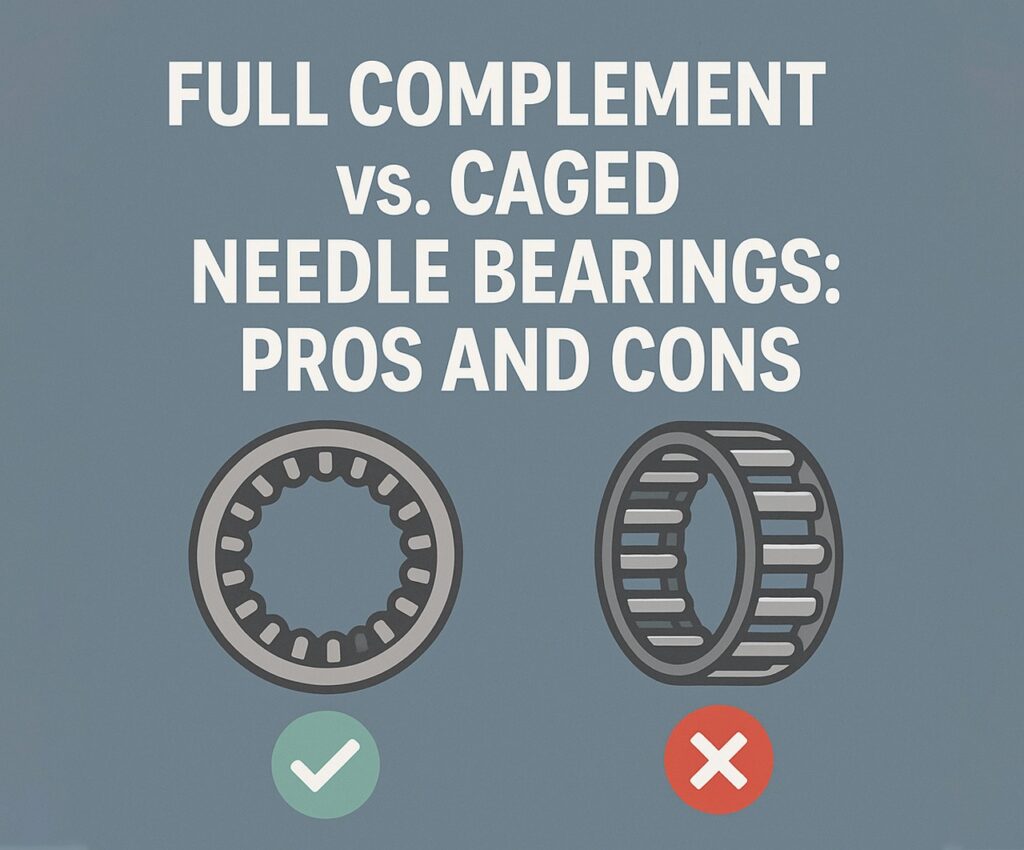In the world of high-precision, high-load bearing applications, needle roller bearings play an essential role. Whether you’re designing a compact cam system with a cam follower needle roller bearing, improving durability in off-road equipment using sealed needle roller bearings, or specifying imperial needle roller bearings for legacy machinery, the choice between full complement and caged needle bearings is a crucial one. This decision directly impacts load capacity, speed performance, lubrication strategy, and ultimately, reliability.
In this detailed guide, we break down the pros and cons of full complement versus caged needle roller bearings, helping you choose the right configuration for your next project or maintenance cycle. Know More
What Are Needle Roller Bearings?
Needle roller bearings are a type of roller bearing with long, thin cylindrical rollers. They are ideal for applications where radial space is limited but high load capacity is required.
Two common configurations include:
- Full complement needle bearings: Completely filled with rollers, no cage.
- Caged needle bearings: Rollers are spaced and guided by a cage or retainer.
Each design has its own strengths and weaknesses, particularly when applied in real-world industrial settings like hydraulic pumps, gearboxes, or track rollers.
Full Complement Needle Bearings: Overview
A full complement bearing uses the maximum number of needle rollers possible within the bearing envelope. This means:
- More rollers = Higher load capacity
- No cage = Higher contact surface area
Key Advantages:
- Superior Load Capacity
- Ideal for static or oscillating loads
- Compact Size
- No need for additional cage components
- Lower Cost in Some Cases
- Fewer components = less manufacturing complexity
Disadvantages:
- Lower Speed Limits
- Rollers rub against each other, increasing friction
- Increased Heat Generation
- Especially under continuous operation
- Greater Lubrication Demands
- Requires frequent or specialized lubrication strategies
For example, in a cam follower needle roller bearing subject to high radial shock but low rotational speed, a full complement design can deliver superior durability.
Caged Needle Bearings: Overview
Caged needle roller bearings use a metal or polymer cage to separate and guide the rollers. This design sacrifices some load capacity in favor of better performance in dynamic systems.
Key Advantages:
- Higher Speed Capability
- Reduced roller-to-roller contact
- Improved Lubrication Flow
- Cage allows better oil or grease circulation
- Less Friction and Heat
- Enhances performance in continuous motion
Disadvantages:
- Lower Load Capacity
- Fewer rollers = smaller contact area
- Slightly Larger Footprint
- Cage adds width in some models
- Potential for Cage Wear
- Especially in dirty or abrasive environments
When working with sealed needle roller bearings, caged designs are preferred for enclosed, high-speed applications where contamination control and lubricant retention are top priorities.
Sealing Options: Adding Protection
In harsh environments, sealed needle roller bearings offer a critical advantage by preventing dirt, dust, and moisture from entering the bearing housing.
Benefits of Sealed Bearings:
- Longer lifespan
- Reduced maintenance intervals
- Consistent performance in outdoor or high-debris areas
Full complement bearings can also be sealed, but due to their reliance on tight packing of rollers, proper lubrication and cleanliness are even more essential.
Choosing Between Full Complement and Caged Bearings
Consider Full Complement When:
- Load is the primary design constraint
- Speed is low or intermittent
- Space is extremely limited
- Shaft support must be maximized
Common in:
- Rock crushers
- Hydraulic actuators
- Automotive gearboxes (low-speed zones)
Choose Caged Bearings When:
- Speed is a major factor
- Continuous rotation is required
- Heat and friction must be minimized
- System involves rapid acceleration/deceleration
Perfect for:
- CNC machines
- Electric motors
- High-speed imperial needle roller bearings used in retrofitted machinery
Case Study: Cam Follower Design
Let’s say you’re designing a cam follower needle roller bearing for a packaging machine that operates 24/7.
- Full Complement: Offers greater static load capacity to handle dwell periods
- Caged Design: Provides higher speed endurance for continuous cam rotation
In many cases, a hybrid approach is taken—selecting a caged needle bearing with reinforced rollers to balance performance and endurance.
Material and Design Considerations
- Roller Material
- Chrome steel (standard)
- Stainless steel (corrosion-resistant)
- Cage Material
- Stamped steel for durability
- Polymer cages for quiet operation
- Lubrication
- Grease: Better for slow to moderate speed
- Oil: Required for high-speed and high-temp
Whether you’re ordering metric or imperial needle roller bearings, consider coatings or finishes that resist rust and improve wear performance.
Speed, Load, and Lifespan Comparison
| Feature | Full Complement | Caged Needle Bearings |
| Max Radial Load | Higher | Moderate |
| Speed Rating | Lower | Higher |
| Friction & Heat | Higher | Lower |
| Maintenance Requirements | Frequent | Less Frequent |
| Lubrication Sensitivity | High | Moderate |
| Suitability for Sealing | Fair | Excellent |
Imperial Needle Roller Bearings: Why They’re Still Used
Imperial needle roller bearings remain popular in North American manufacturing due to legacy equipment. When retrofitting or repairing older machines:
- Full complement options are often drop-in compatible
- Caged designs can improve performance in modernized systems
Industries like aerospace, rail, and agriculture still rely on imperial sizes, making the choice between caged and full complement vital for performance upgrades.
Maintenance and Troubleshooting
Signs of Trouble:
- Excessive heat around the bearing
- Noise or chatter during operation
- Accelerated wear or pitting
Maintenance Tips:
- Regular inspection and relubrication
- Avoid mixing bearing types on the same shaft
- Replace seals in sealed needle roller bearings every 12–18 months in harsh environments
Final Thoughts
Choosing between full complement and caged needle roller bearings isn’t just a technical detail—it’s a design decision that affects every aspect of your system, from performance and durability to maintenance and cost. If you’re working with a cam follower needle roller bearing in a rugged industrial setup, a full complement design may give you the load support you need. On the other hand, if your application involves high RPM and continuous duty cycles, sealed needle roller bearings with caged rollers are often the better fit.
And when dealing with older machinery or custom fits, don’t forget the role of imperial needle roller bearings—they still pack a punch in today’s precision applications.
By understanding the trade-offs between these configurations, you can make smarter engineering decisions and get more from every rotation.

